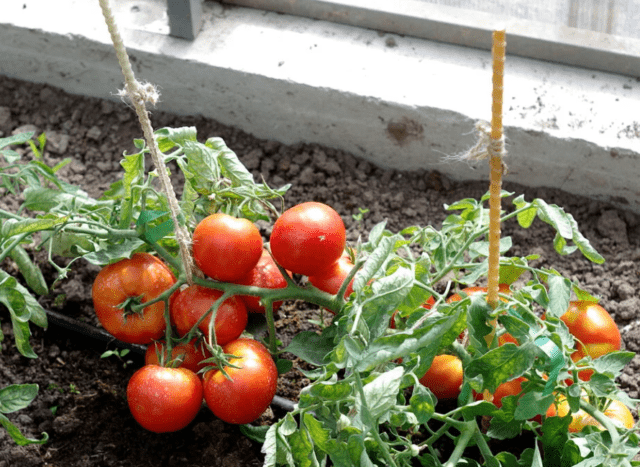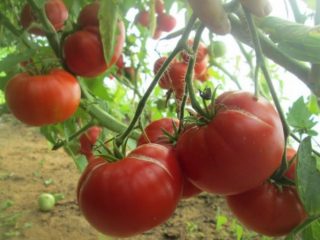Content
- 1 History of selection
- 2 Description of the tomato variety Gardener's Dream
- 3 Characteristics of a gardener's dream tomato
- 4 Advantages and disadvantages of the tomato: A gardener's dream
- 5 Features of cultivation
- 6 Pest and disease control
- 7 Conclusion
- 8 Reviews from gardeners about the tomato Gardener's Dream
Early ripening varieties and hybrids of tomatoes are consistently in demand among amateur gardeners. This category also includes the Gardener's Dream tomato. In addition to early ripening, it is distinguished by its ease of care, good immunity, “massive” fruiting, consistently good yield and compactness of plants. Therefore, for more than ten years it has been successfully “competing” with new breeding products that appear on the market every year.
History of selection
Tomato A gardener's dream is the achievement of one of the most famous Russian agricultural companies, Sedek. Several breeders worked on it, the authors named A. N. Lukyanenko, I. N. and S. V. Dubinin.
An application for official registration was submitted in 2006; since 2007, the variety has been listed in the domestic State Register of Breeding Achievements.Tests have confirmed its suitability for cultivation in all Russian regions where gardening is generally possible, including those that are rightly called “risky farming zones.”

Russian gardeners consider the agricultural company producing tomato seeds A Gardener's Dream to be reputable and trustworthy
Description of the tomato variety Gardener's Dream
A gardener's dream is an early-ripening variety of tomatoes, suitable for cultivation in open and closed ground. From the moment the seeds germinate until the first fruits are harvested, 90-100 days pass. According to the originator, their ripening period is even shorter - 80-95 days. This is likely influenced by climatic and weather conditions. Tomatoes ripen en masse, the first “wave” is approximately 70% of the total harvest.
Tomato bushes: A gardener's dream, determinate. They never stretch beyond the limit “set” by the breeders. In open ground the height is 60-70 cm, in a greenhouse - 10-15 cm more. The stems are powerful, the leaves are medium-sized, the foliage is average.
The fruits look very presentable. Gardener's Dream tomatoes are one-dimensional, weighing about 80 g, rare specimens gain weight of 140-150 g. The shape is standard for tomatoes - round, slightly flattened. The ribbing is very weakly expressed. The skin is uniformly red in color, without a light spot at the stalk, glossy. Its density and elasticity provide tomatoes with good shelf life and transportability.

Despite their compactness and small size, the bushes need staking and shaping
The taste is officially recognized as “good”.In it, the sourness typical of tomatoes is “balanced” by sweetish notes and aftertaste. The pulp is juicy and tender, of medium density. The fruits of the Gardener's Dream tomatoes are multi-chambered (4-5 or more), they contain a lot of seeds.
Characteristics of a gardener's dream tomato
Most gardeners, when describing the “Gardener’s Dream” tomatoes, are “captivated” by the combination of compactness and consistently high yield. Good immunity is also important.
Tomato yield: A gardener's dream
The yield for small bushes is very good - about 6.3 kg/m². Gardener's Dream tomatoes are easy to pick thanks to the articulation on the stalk. The type of fruiting is carpal, each cluster contains 4-6 tomatoes. At least five fruit clusters are formed on the bushes (usually 7-9). They are laid like this: the first one is above the 5-7th sheet, then every two sheets.

Tomatoes on clusters ripen almost simultaneously, ensuring uniform fruiting
Resistance to diseases and pests
The Gardener's Dream tomato has an “innate” immunity to blossom end and root rot. The originator also claims that the variety is resistant to fusarium, alternaria, verticillium, late blight, and various types of mosaic virus. Reviews from gardeners confirm this information. Based on their experience, diseases are exceptional for this variety, even if the weather is favorable for pathogen activity.
Methods of application
In the State Register the variety is listed as a salad variety. However, due to their small size, tomatoes are quite suitable for whole-fruit canning.After pickling and salting, Gardener's Dream tomatoes do not lose their presentability - they retain their bright color, the skin rarely cracks, and the flesh does not “dissolve” into mush. They are also used as a “raw material” for homemade juice, tomato paste, and ketchup.

Gardeners in their reviews note that the Gardener’s Dream tomato harvest is enough for both summer salads and winter preparations
Advantages and disadvantages of the tomato: A gardener's dream
The stable demand for the gardener’s dream tomato is due to a long list of its significant advantages:
- suitability for planting in open ground, under film covers, in greenhouses, greenhouses;
- the ability to grow in almost any Russian region;
- care that takes a minimum of time and effort from the gardener;
- the presence of “innate” immunity to various types of rot and generally good resistance to pathogens;
- compactness and small height of plants;
- early ripeness, “friendliness” of fruiting;
- consistently high yields, regardless of how lucky the gardener is with the weather in spring and summer;
- the possibility of propagation by self-collected seeds;
- “presentation” and one-dimensionality of tomatoes;
- versatility of crop purpose;
- balanced taste of fruits, their health benefits;
- Very good shelf life and transportability for tomatoes.

Gardener's Dream tomatoes look very presentable both on the bushes and in home preparations
The only disadvantage of the Gardener's Dream tomato variety is the need to form bushes, tie up fruit clusters, and regularly remove shoots. In addition, “highly productive” plants require enhanced feeding.
Features of cultivation
Despite the early ripeness and general endurance, gardeners mainly practice growing the Gardener's Dream tomato in seedlings. The seedlings grow to the required dimensions (height 12-15 cm, presence of 5-6 true leaves) in about two months. Based on this, the timing of planting seeds for seedlings is determined. It can be transferred to the ground only when the likelihood of spring frosts becomes minimal.
It is advisable to immediately plant the gardener's dream tomato seeds in separate containers, so that later you do not have to pick up the seedlings. The best option is small peat pots, from which the seedlings do not need to be removed before transplanting to a permanent location.

Depending on the region and growing conditions, the time for planting tomato seedlings is a gardener's dream - the end of April, May and even the beginning of June
It is impossible to grow strong, healthy seedlings unless you provide them with 10-12 hours of daylight. Watering is also important - you should neither overdry the soil nor overwater the seedlings.
4-5 tomato bushes are planted per 1 m². A gardener’s dream. The distance between them is 35-45 cm, between the rows - 40-50 cm. The selected area is first dug up and fertilizers are applied.

When planting, the seedlings should not be deeply buried - maximum to the lower (cotyledon) leaves.
Agricultural technology for tomatoes A gardener's dream requires a standard one. Caring for them includes:
- Watering. The intervals directly depend on the weather outside (air temperature, intensity of precipitation). On average, twice a week is enough.The approximate norm is 4-5 liters per tomato bush. A gardener's dream.
- Loosening and weeding. There is an alternative to these measures - mulching. If the bed is not covered with mulch, it is loosened about once a week, while pulling out weeds. Do this the next day after watering.
- Fertilizer application. The Gardener's Dream tomatoes are fed for the first time 7-10 days after transplanting the seedlings into the ground. To activate the growth of green mass, use a solution of any mineral nitrogen fertilizer. Next, fertilizing is applied every 12-15 days from the end of flowering.
- Shaping and gartering. Tomato bushes, a gardener's dream, are recommended to be “maintained” in one or two stems. Other stepsons are regularly removed, not allowing them to stretch more than 2-3 cm. Fruit clusters are tied up as they form; the stems often cannot withstand their weight.

The stepson, located immediately under the first fruit cluster, is turned into the second shoot.
Pest and disease control
The Gardener's Dream tomato has an “innate” immunity to the most dangerous diseases for the crop. To protect plants from other pathogenic fungi, it is enough to have competent agricultural technology and adherence to a planting scheme to avoid “crowding” in the garden bed. For prevention, seeds are pickled in a solution of any fungicide (15-20 minutes). The same drugs are used once every 2-3 weeks, when the summer is cool and rainy.

It is impossible to get rid of aphids on tomatoes unless you remove the ants with which they form a symbiosis from the garden bed.
Pests on Gardener's Dream tomatoes can only be detected in the event of their “mass” invasions of the garden plot (and this is an infrequent occurrence). Many insects are immediately repelled by the pungent smell of tomato tops. Exceptions: aphids (small brown-black “bugs”), thrips (black “sticks”) and whiteflies (whitish “butterflies”).

In severe cases, when thrips attacks, a silvery tint appears on the underside of the leaves.
All these pests feed on plant juices. If nothing is done, the affected tissue areas become discolored, becoming almost transparent, dry out and die. Any universal insecticide is suitable for controlling these insects. Both the Gardener's Dream tomato bushes and the soil underneath are sprayed.

In the vast majority of cases, whiteflies attack tomatoes grown in a greenhouse.
Conclusion
Tomato A gardener's dream fully justifies its loud name. It is suitable for cultivation in most Russian regions, is easy to care for, and rarely suffers from diseases and pests. The yield, despite the “small size” of the plants, is very good, fruiting is massive. The taste of early-ripening tomatoes is simply excellent.
Reviews from gardeners about the tomato Gardener's Dream








